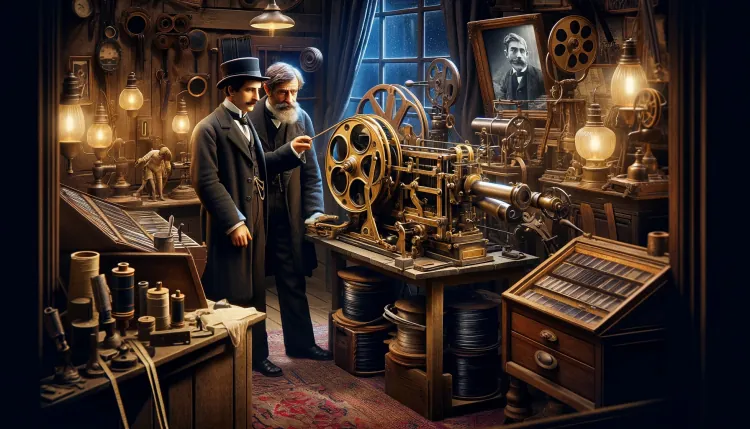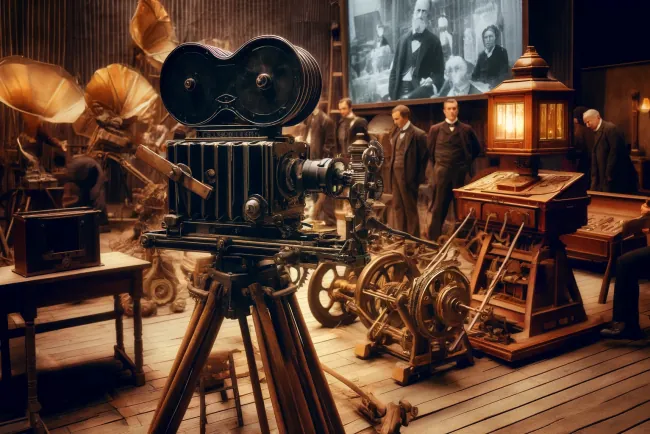Unveiling the Lumière Brothers: Pioneers of Cinema
Discover the lives of the Lumière brothers, their invention of the Cinématographe, and their lasting impact on cinema and photography.

Introduction
The Lumière brothers, Auguste and Louis, are foundational figures in the annals of cinematic history, best known for their revolutionary Cinématographe. However, their influence extends beyond this invention, touching on broader cultural, technological, and artistic realms of their era. This article explores their multifaceted contributions and the lesser-known facets of their lives.
Outline
- Early Life and Background
- Family Influence
- Education and Early Innovations
- The Birth of the Cinématographe
- Initial Inspiration
- Development and Patent
- The First Public Screening
- The Grand Café Debut
- Audience Reaction and Historical Impact
- Beyond Cinema: Diverse Inventions
- Color Photography: The Autochrome Plate
- Other Technological Contributions
- Later Life and Legacy
- Departure from Cinema
- Contributions to Other Fields
- Conclusion
Early Life and Background
Family Influence
Growing up in a creative household under Antoine Lumière, a talented painter and photographer, Auguste and Louis were naturally inclined towards the visual arts. This upbringing was crucial in shaping their inventive perspectives.
Education and Early Innovations
Both brothers were educated at La Martiniere in Lyon, where they honed their technical skills. Their father's business also provided hands-on experience with photographic equipment, fostering their early interest in visual technology.
The Birth of the Cinématographe
Initial Inspiration
The concept of the Cinématographe was sparked after their father viewed Edison’s Kinetoscope. Antoine challenged his sons to improve upon Edison's design, leading to their groundbreaking invention.
Development and Patent
The Cinématographe, patented in February 1895, was a marvel of engineering, combining the functions of filming, projecting, and developing into one portable device, a significant advancement over the cumbersome Kinetograph.
The First Public Screening
The Grand Café Debut
The brothers’ first public film screening in December 1895 at Salon Indien du Grand Café in Paris was a pivotal moment in cinema history, showcasing ten short films that demonstrated the potential of moving pictures.
Audience Reaction and Historical Impact
The screening included "The Arrival of a Train at La Ciotat Station," which famously astounded viewers, reflecting the profound immediate impact of moving images on the public.
Beyond Cinema: Diverse Inventions
Color Photography: The Autochrome Plate
Beyond their cinematic achievements, the Lumière brothers pioneered the Autochrome plate, the first successful color photography technique, which used dyed potato starch in its composition.
Other Technological Contributions
Their innovations extended to various fields, including medical research and stereoscopic photography, illustrating their broad impact on technological development.
Later Life and Legacy
Departure from Cinema
By 1905, despite their cinematic success, the brothers shifted their focus to other interests, famously underestimating the future significance of cinema.
Contributions to Other Fields
Louis delved into medical research, while Auguste focused on scientific studies, continuing to innovate and influence various technology sectors until their deaths.
Conclusion
The Lumière brothers’ legacy is a testament to their pioneering spirit and their wide-ranging impact on both the art of cinema and the technological landscape of photography. Their story is not merely about the devices they created but about their enduring influence on the narrative and visual capacities of media technologies.
What's Your Reaction?






















